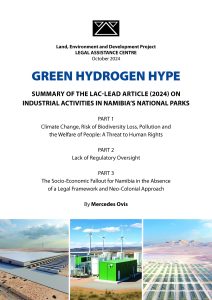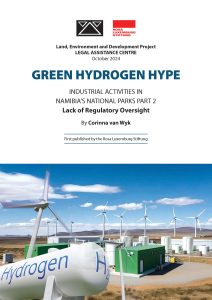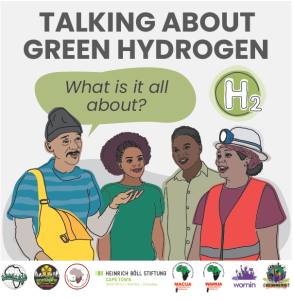
Sustainable Development is a wide topic.
LEAD focusses on four key areas of interventions, the roles with regard to natural resource management, roles with regard to planning of natural resource management, support to Community Based Natural Resource Management (CBNRM) and support to marginalised/indigenous peoples (such as the San).
We follow the following objectives:
- Natural Resource Management Roles are clear and accountable, see also DRFN publication for more info.
- SEA/Land Use/Development/Structural – Planning Roles are reconciled, clear and accountable
- CBNRM is expanded, harmonized and accountable, see also NACSO
- Marginalized people (such as the San) are empowered to meaningfully participate in their own development in fostering stronger socio-economic and political ties as equal citizens of the Namibian society
- Extractive industries
- Greeen Hydrogen
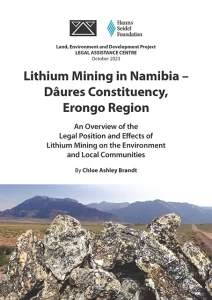 Lithium Mining
Lithium Mining
Lithium Mining in the Dâures Constituency – An Overview of the Legal Position and Effects of Lithium Mining on the Environment and Local Communities
Mining is Namibia’s leading economic sector, accounting for about 10% of the country’s GDP every year, and for over 50% of its export revenues. Diamond and uranium oxide mining have been the leading subsectors, and lithium mining has been gaining traction in recent years, due to lithium’s potential in the sphere of renewable energy technologies. Lithium-ion batteries currently have the highest energy density, the longest life cycle and the widest temperature range tolerance, and their self-discharge rates are the lowest among all varieties of rechargeable batteries. Lithium is also used in glass, lubricants and air purifiers. Lithium (from the Greek word lithos, meaning ‘stone’) is a chemical element, which in elemental form presents as a soft silvery-white alkali metal. It is mostly found in deposits of hard rock (pegmatites), this being the case in Namibia, and in brine deposits. After the rocks containing lithium have been extracted from the mine, the minerals containing the lithium are extracted from the rocks, and then the lithium itself is isolated.
Effects on the environment and local communities
Lithium mining can have various effects on the environment and the communities living in the vicinity of the mine. Noted positive effects include the creation of infrastructure such as roads and shopping centres, facilities such as banks and services such as educational programmes. However, there are several risks for the environment and population. Read more here.
Tin Mining
Oil, gas and mining development has historically led to the loss of lands, livelihoods and community cohesion for indigenous and local communities living close to the respective industrial activities. At the same time, these industries have contributed to local socio-economic development in the applicable regions. For example, the tin mine (Andrada Mining Limited) located in Uis, Erongo Region, has helped to resuscitate the town, which has been in decline. The mine employs more than 200 locals and has contributed to reviving activities such as educational competitions and tournaments for the Uis community.1 Hence, although indigenous communities, due to their close relationships with the land, water and resources therein, and their marginalised social and economic positions, are particularly vulnerable to mining impacts, there is potential for them to benefit from opportunities that the mines create.
This paper discusses how the extraction of natural resources has the potential to exploit local host communities, and the issue of notoriously non-compliant “public consultations” and the State’s lack of enforcement of the principles of public consultation.
Firstly, the paper states the current legal position on public participation and consultations; and secondly, it discusses issues around the enforceability of the law, with reference to the Reconnaissance Energy Africa Ltd (“RECON”) case, inter alia.
The Hydrogen Hype
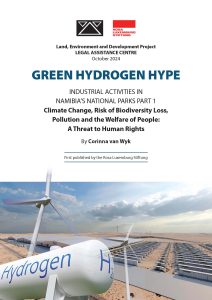
Namibia has given approval for the production of green hydrogen in ecologically sensitive national parks along the Atlantic Ocean coastline. The largest of the approved projects is located in the Tsau ||Khaeb National Park. The United Nations High Commissioner for Human Rights has described the triple planetary crisis of climate change, biodiversity loss and pollution as the biggest threat to human rights globally.
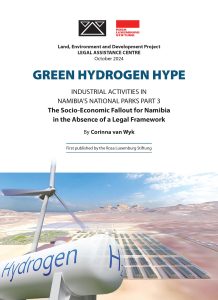
In the last part of the article takes a closer look at the role of investors from developed countries and the neo-colonial approach that has emerged in the wake of the hydrogen hype.
Experts in Namibia hold that there is a lack of strategic thinking and planning, and an indecent haste with which Germany, the EU and Namibian politicians are pushing this green agenda forward despite its considerable ecological and socio-economic harm to an already vulnerable climate.
Protection of local communities
Namibia ratified the Convention on Biological Diversity on 16 May 1997, and acceded to the Nagoya Protocol, a complementary agreement to the Convention, on 15 May 2014.
The Nagoya Protocol addresses the issue of fair and equitable sharing of benefits arising from the utilisation of genetic resources, and the associated issues of genetic resources in the hands of local communities and the traditional knowledge associated with genetic resources. When accessing such resources, Contracting Parties are held to ensure free, prior and informed consent by the local community concerned, and fair and equitable benefit-sharing mechanisms. Namibia’s Access to Biological and Genetic Resources and Associated Traditional Knowledge Act, 2017 (the “ABS Act” ) provides for implementing the Nagoya Protocol in this country.
We have published a short report on the topic here.
Forestry
LEAD approached the Ombudsman’s Office with a view to ascertaining its stance regarding the ongoing timber-harvesting controversy in Kavango Region. The Ombudsman expressed a desire to support any legal intervention to curb the illicit trade, but how this could be accomplished or what strategy may be employed was not readily ascertainable. Various government statements have suggested that a moratorium is in place and that cross-border timber transit is properly monitored. There is some evidence to support the view that harvesting permits are issued unscrupulously and harvesting is not limited to defined areas or species, or according to any environmental management programme.
LEAD is researching this matter and will possibly embark on a legal intervention strategy to control unsustainable forest and ecosystem destruction. LEAD has meanwhile addressed the Parliamentary Standing Committee on Natural Resources and Economics on the negative impact of unsustainable logging of indigenous wood species in Namibia.
Oil exploration
LEAD has been given the status of “interested party” to the proceedings taking place in Kavango regarding oil exploration, and we have received complaints by directly affected parties regarding the process and stages of exploration. These parties also include indigenous people living from the natural resources affected by the operation. LEAD continues to provide support to the traditional authorities, ranging from assistance with litigation to the drafting of trust deeds and providing advice regarding the Traditional Authorities Act and how to properly address its requirements.
Please also read our page on the topic as well as ProBono on Environmental Assesments.



